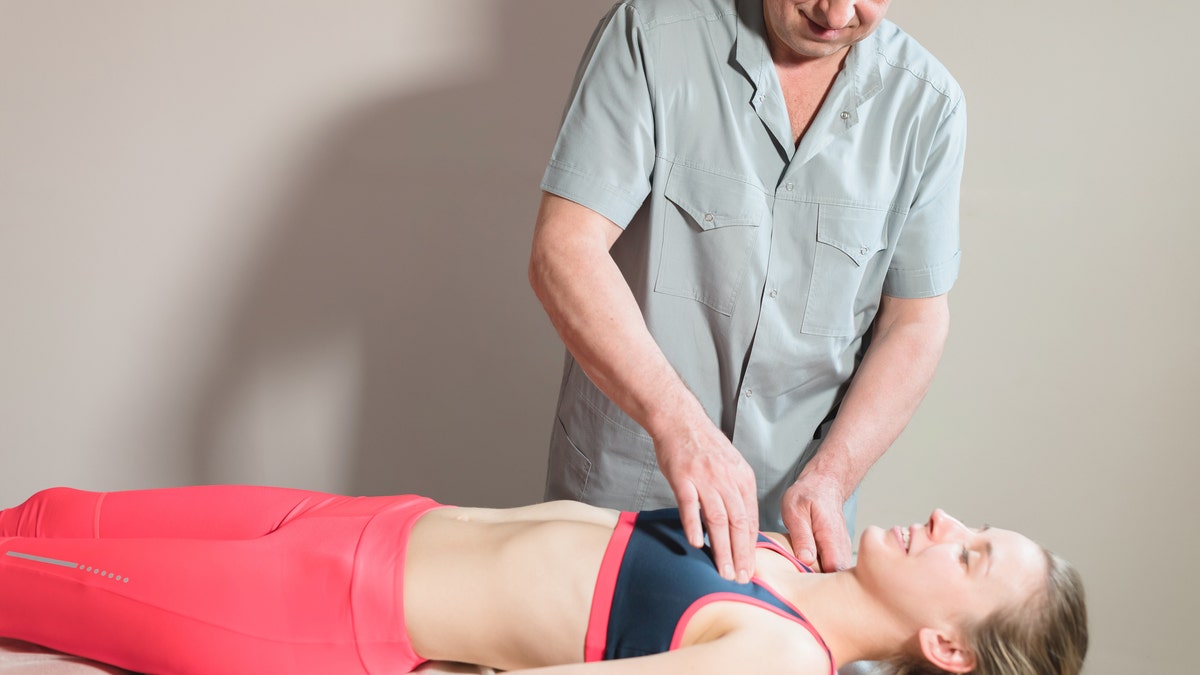A special type of physical therapy is helping some patients with the novel coronavirus breathe more easily. The type of physical therapy, called manual therapy, is a bit different from the typical physical therapy and has helped some COVID-19 patients.
“When I first got out of the hospital in late April, I could not even sit up for 30 minutes. My oxygen saturation rate on the pulse oximeter would plummet to the 80s when I tried to stand and move around to cook in the kitchen, even with 6 liters of oxygen," Dr. Douglas Dieterich told Fox News.
Dieterich, a hepatologist at Mount Sinai Hospital in New York City, was infected with the novel coronavirus in March and spent over three weeks in the ICU and hospital.
PRELIMINARY STUDY INVESTIGATES HOW CORONAVIRUS PARTICLES MAY TRAVEL IN CLASSROOMS, INDOOR AREAS
“Physical therapy for me before COVID was common for orthopedic injuries. This was different," Dieterich said of manual therapy. “After I got home, my physical therapist was also certified in manual therapy so she addressed how my joints in the rib cage worked.”
The physician explained how they dealt with social distancing during treatments.

Manual therapy techniques to chest muscles may help patients breathe easier.
(iStock)
"Since COVID exposure was a concern for her, we did virtual PT and she taught me self-massage techniques for the muscles between my ribs," he said.
"The act of breathing is automatic but the depth of breath is dependent on the muscles functioning and the rib cage working efficiently,” Valerie Harris, who practices manual physical therapy at Thrive Integrated Physical Therapy in New York City, told Fox News.
"Physical therapists can work to improve the efficient function of respiration through soft tissue release of restricted rib cage and thoracic musculature," Harris added. “Joint mobilizations of the individual ribs and thoracic spine can be implemented to return the natural glide and motion needed for a full inhalation/exhalation."
The physical therapist said incorporating breathing exercises during and after these techniques allows for greater lung expansion and may help with a greater diffusion of oxygen throughout the body.
The novel coronavirus creates inflammation and attacks the lung tissue, according to health experts. Breathing becomes compromised and the patients typically become generally weak.
“The muscles were so tight and deconditioned from weeks in the hospital. It was difficult to take a deep breath in; the manual physical therapy really got in there and helped get the ribs to actually separate as I took a deep breath," Dieterich said.
“When I first got out of the hospital in late April, I could not even sit up for 30 minutes. My oxygen saturation rate on the pulse oximeter would plummet to the 80s when I tried to stand and move around to cook in the kitchen, even with 6 liters of oxygen."
Besides addressing the rib mobility, the physician said treatment also focused on the diaphragm, the muscle just under your rib cage.
“The diaphragm is the primary muscle of respiration and during inspiration, it contracts and pulls downward," said Harris.
She explained how the muscles between the ribs, which are known as the intercostals muscles, work with the diaphragm to expand the chest to allow air to fill the lungs. When they are tight, the chest can’t expand as efficiently, according to the physical therapist.
"This tightness is typically seen in post-COVID patients who were in the ICU," Tamar Amitay, a physical therapist who also practices manual therapy techniques, told Fox News.
"ICU-acquired weakness occurs in 33 percent of all patients on ventilators and up to 50 percent of patients who are in the ICU for greater than one week," Amitay, the owner of Thrive PT, added.
HOMEMADE CORONAVIRUS FACE MASKS SHOULD BE TWO OR THREE LAYERS TO STOP SPREAD OF VIRUS, STUDY FINDS
Physical therapists say the muscles compensate for the weakness in many COVID-19 patients and many muscles no longer contract properly, which can contribute to inefficient breathing patterns.
“Patients who have been in respiratory distress may use their accessory muscles of respiration versus their diaphragm," said Amitay. “This increases the work of breathing."
Both physical therapists say when these muscles are tight, these manual techniques along with stretching and breathing exercises can really help patients recovering from COVID-19. Dieterich said the virtual sessions appear to be helping him in his recovery.
Although he has a long road to full recovery ahead, he noted that he can now "walk 2 miles on 2 liters [of oxygen], although I get tired and have to rest afterward.”



















